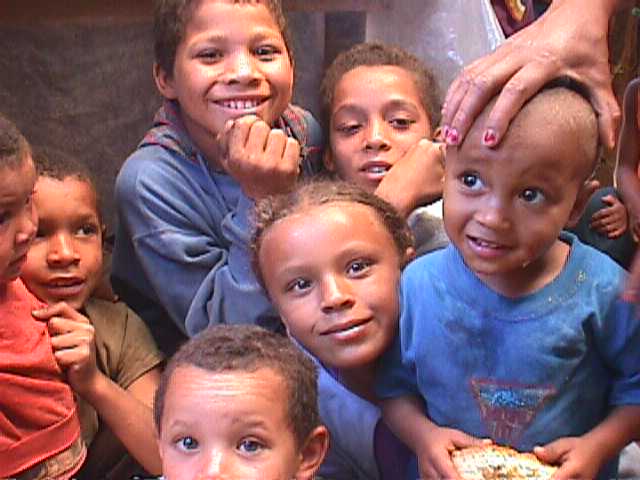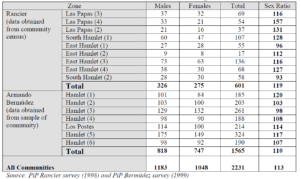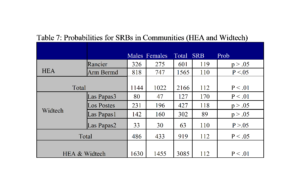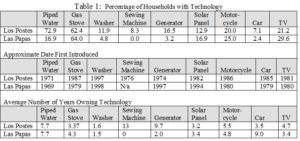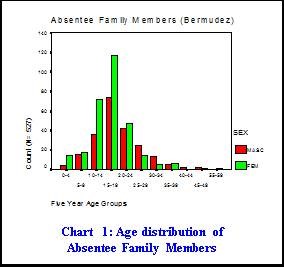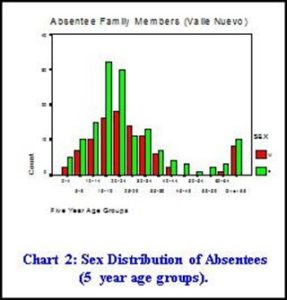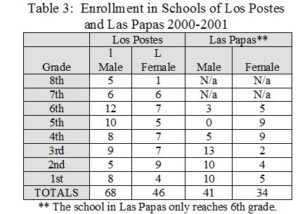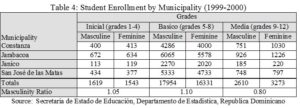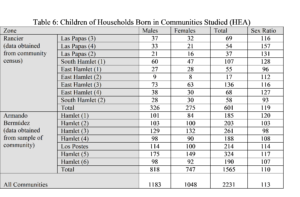First published on June 16, 2012 on Open Salon
This white paper treats demographic trends found in mountain park areas of the Dominican Republic. The reason that I am publishing here is that I believe it provides a fascinating contrast to demographic conditions found on the other side of the border, in rural Haiti, where differential configurations of labor tasks mean that girls rather than boys are more valuable in making households productive. The differential labor demands make a whole array of behavior patterns understandable. Including parents preference for boys versus girls, differential age at first union, probability of education, probability of migrating to urban areas, and male/female sex ratios.It also highlights an issue of scholarly importance but that no one seems to pay attention to: specifically, there is strong evidence that the rural Dominican Republic has birth sex ratios skewed toward males far in excess of the rates that make China and India famous for their ‘missing girls.’The research presented comes from surveys and case studies that I and my colleague Matthew McPherson conducted along the borders of Rancier and Bermúdez National parks in the Cordillera Central Mountain range of the Dominican Republic. McPherson was the PI and team leader in both projects. The first was conducted under the auspices of The Nature Conservancy and the Dominican Government, involved two surveys (1998-1999) and a total of 598 households located in sixteen communities. The data from these surveys is referred to below as HEA data.[i]
INTRODUCTION
To begin with there is a spectacular and statistically highly unlikely difference in the number of male vs. female children born in the park communities. The expected natural sex ratio is 105 males to 100 females. In Tables 1 and Table 7 show that something is not natural. In 11 of 15 communities studied, the birth sex ratio exceeds the expected 105 to 100 females. The overall sex ratio for the communities is 113 males to 100 females. In table 7 we have aggregated the data by sources, the Dominican census data on the one hand and the data collected during our USAID/WIDTECH study on the other. Both demonstrate ratios differ from the expect 105 males per 100 females at a levels below p = .05. Combined, they are significantly different from the expected natural birth ratio at the level of p=.01.
Table 1: Children Born into Studied Households
In coming to explain the unnatural difference found in community sex ratios at birth, we looked at the motivations that might make people prefer girls of boys. Over the past three to four decades the dramatic increase in the availability of inexpensive and already processed foods, the availability of labor saving devices, the rapidly increasing numbers of Haitian migrant laborers and, most of all, the formation of national parks with the concomitant restrictions on access to resources altered the balance in female versus male labor contributions to household livelihood strategies. The reorganization of production as a response to the formation of parks and the strict application of conservation policies deprived campesinos of recourse to much of their traditional swidden garden land and livestock range. Men responded by intensifying the use of what little land remained available to them and turning to extra-household income generating occupations. Boys remained valuable for their performance of non-remunerated tasks that still needed to be accomplished, such as gathering wood for fences, gathering fruits, and tending to livestock. But contributions from women and girls became less critical to the labor processes that sustained households. Concurrent with park formation, new trade policies brought about by international pressure in combination with “food relief” opened the floodgates to inexpensive imported foods, foods that were pre-processed and also reduced the demands for female labor. The introduction of labor saving technologies such as piped water, laundry machines, and gas stoves further reduced demand for female household labor. The incursion of inexpensive Haitian labor reduced the workload of female and child labor on the homestead, and all but completely eliminated the role of female labor in coffee harvests, the major traditional female economic opportunity in the mountain park areas. The demographic consequences of reduced demand for female labor has been,
- high rural female versus male out-migration leading to some of the highest male-biased adult sex ratios in Latin America,
- extremely high female versus male secondary school enrollment,
- the youngest recorded female ages at first marriage in the Western hemisphere, and
- sex ratios at birth (SRBs) unnaturally skewed in favor of males and suggestive of differential female versus male fetal or infant mortality.
Research
As mentioned, the research presented comes from surveys and case studies carried out by myself and my colleague Matthew McPherson along the borders of Rancier and Bermúdez National parks in the Cordillera Central Mountain range of the Dominican Republic. The first project was conducted under the auspices of The Nature Conservancy and the Dominican Government, involved two surveys (1998-1999) and a total of 598 households located in sixteen communities. The data from these surveys is referred to below as HEA data.[ii]
The second research project (2001) was conducted under the auspices of Facultad Latinoamericana de Ciencias Sociales (FLACSO), The Nature Conservancy, and USAID’s Women in Development Technical Assistance Project (Widtech) and was designed to investigate the implications of high male to female sex ratios evident in much of the rural Dominican Republic, particularly the most remote areas. Qualitative and quantitative surveys were conducted in two rural Dominican secciones, political units similar to counties in the United States, herein referred to by the fictional names “Los Postes” and “Las Papas.” [iii][iv]
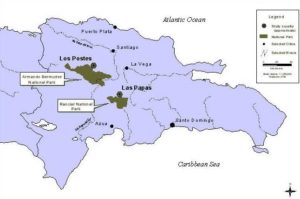
Over the past four decades a complex of national and international economic trends, policies, and legislation impinged on household livelihood strategies and domestic life in the park areas. The labor contributions made by females living in the vicinity of parks became, in the struggle to meet subsistence demands, increasingly less valuable than male labor. Understanding these processes, however, necessitates first a look at the traditional sexual and age division of labor and how it changed, or rather did not change, over the past three decades.Until recently livelihood strategies in the communities studied were characterized by strenuous work regimes and a rigid gender division of labor. Men were oriented toward the world outside of the homestead. They cleared swidden garden plots, planted crops, gathered firewood, cut lumber, raised large animals, built and maintained houses and fences. They also dominated local political and administrative leadership roles and, unlike elsewhere in the Caribbean such as in neighboring Haiti, men controlled regional commerce, making long trips on mule to markets where they sold products of the household and gardens and made necessary purchases.
The domain of women was the household. Female involvement in activities outside the home was rare, restricted primarily to participation in agricultural harvests and to a lesser extent the planting of short cycle crops such as beans and corn. But the female household tasks performed equaled or exceeded in rigor the demands placed on men. Women processed food, cooked meals, retrieved water, washed clothes, cleaned house, made and mended clothes, tended kitchen gardens and cared for small livestock such as poultry and goats.
Children too were critical in traditional campesino household production strategies. Beginning at four or five years of age, both male and female children aided women in the completion of household chores. By seven or eight years of age tasks began to be differentiated according to the gender of the child. Male children were expected to begin participating with men in agricultural labor tasks, fixing fences and taking responsibility for large livestock. At harvest time, male children participated in the shelling of coffee beans, a tedious endeavor that involved long hours of turning mills by hand. Girls helped their mothers, fetching water, participating in the preparation of food, taking food to the males in the conuco (fields), and cleaning house. Girls also participated with their mothers in harvesting coffee, the most important remunerated labor task open to females in the Cordillera Central.
Changing Age and Gender Division of Labor
The gender and age division of labor has changed little over the past three to four decades. Female contributions continue to be centered on household tasks and male work activities continue to be focused outside the household. What changed, however, were the factors that determined the extent of demands for female versus male labor, and as will be seen, gave way to the demographic trends outlined earlier: High female out-migration, higher female enrollment in secondary school, low female age at co-habitation, and sex ratios at birth that favor males. Specifically, lower demand for female labor was precipitated by,
- park formation
- increased availability of imported processed foods and goods,
- the increasing availability of labor saving devices,
- the increasing availability of inexpensive Haitian labor
A) Park Formation
With the creation of Armando Bermúdez National Park in 1956 and then in 1983 another park, Juan Pérez Rancier National Park,[v] 25% of the Cordillera Central mountain range was effectively legislated out of existence for the peasant producers who lived in the area (Figure 1). The creation of these parks subsequently changed the configuration and gender specific demands inherent in traditional household-oriented productive strategies difficult because,
1) land was made unavailable,
2) restrictions were placed on cultivation and grazing in buffer zones, and
3) credit from agricultural banks was denied to park-area farmers.
These proceses affected men and women differently. For men, because the amount of land available for traditional male campesino subsistence activities, principally gardening and livestock rearing, was severely restricted, those who did not migrate to urban areas were forced to intensify agricultural production on the little land that remained available. Others sought employment in the agro-industrial sector, or turned to alternative subsistence strategies such as involvement in trade, or they devised new strategies based on a combination of opportunities such as clandestine lumbering and poaching of honey, parrots, and wild hogs. But while men intensified income generating activities outside the household, women found themselves with less to do on the home front, less garden and animal products to process.
B) Increased Availability of Imported Processed Foods and Goods
The Dominican conservation movement manifest in the formation of protected areas coincided with State policies designed to shift the Dominican economy from one focused on small scale agricultural production to one focused on large scale agro-industry and urban manufacturing. U.S. policy planners initiated the process. With the 1966 U.S. military invasion of the Dominican Republic, USAID (United States Agency to International Development) gained control of the Dominican policy planning decisions. The subsequent shift to the promotion of agro-industry and urban based manufacturing relied on a low-wage labor force located where the labor was needed. This meant migration to urban or agro-industrial areas. To encourage the migration while at the same time providing a cheap source of food and discouraging alternative income generating opportunities, price controls were applied to basic food staples, an effort complemented by the massive importation of inexpensive U.S. subsidized and pre- processed foods. The importation and targeted transition was complemented by the gratuitous distribution of U.S. grains and vegetable oils in the form of ‘food relief.’ Thus by 1966 the fertile Dominican Republic, only five years earlier the only country in the Caribbean self-sufficient in all agricultural products except wheat, was second only to Vietnam as the world’s highest per capita recipient of U.S. food aid. The domestic agricultural market was effectively shattered and a massive migration into urban areas begun (Georges 1990:30; Turits 2003: 20 ).
The process had a direct impact on male versus female household labor demands. Artificial price ceilings on domestic agricultural produce and the flooding of the market with gratuitous ready-to-cook food reduced incentives for the production of surplus staples. Imported processed food became a major part of the Dominican diet. In the park regions, where farmers had also been deprived of access to traditional swidden garden and grazing land, the impact on households was especially hard. Men were desperately trying to hang onto traditional subsistence strategies, working harder, with less to produce enough income to support families while campesino women in the park areas were cooking processed foods, effectively lowering the amount of time they were engaged in productive household labor activities.
C: Modernization of Daily Life
The processes described above were complemented by the incidental introduction of labor saving devices such as propane stoves, motor powered mills, piped water, and washing machines (Table 1). The introduction of labor saving devices translated to a spectacular reduction in the time necessary to accomplish household chores, cook, and process market crops such as coffee. Introduction of propane stoves, for instance, meant that the time necessary to cook meals dropped from four to less than two hours per day. Time dedicated to washing cloths dropped from 16 hours per week—16 hours of hand scrubbing– to zero as they could effectively be washed in laundry machines while women tended to other household activities. It was no longer necessary to take four and five trips per day to fetch water as it was now piped directly into many homes, and long hours pounding grains and coffee were eliminated by the widespread availability of automated mills. Once again, women found themselves in less demand.
Haitian laborers have long been present in lowland Dominican sugar plantations but it was only in the 1980s with the relaxing of controls on both sides of the border that Haitians first began arriving in Cordillera Central park regions. The current population of Haitian migrant workers is entirely male and depending on the season ranges from 10% to 25% of the population in the studied communities (Haitian workers are not included in the national census or the samples described herein). For wages less than half that demanded by Dominicans, Haitians weed gardens, cut grass, tend livestock, and construct houses, all activities that effectively reduce demands on Dominican males. But the impact has been equally great on females. In exchange for board and meals Haitians perform many of the household labor tasks that traditionally fell to women, including food processing and tending small livestock. Perhaps most significantly of all, Haitians have all but completely taken over the task of harvesting coffee, the primary traditional extra-household income opportunity available to women.Consequences of Lower Demand for Female Labor
Lower contributions made by women to household livelihood strategies reverberated through the social system of park communities. While trying to hold onto male children, rural families in the park areas were and still are taking steps to release or “unload” female children at increasingly younger ages. The primary mechanisms identified through which families ‘release’ females are precisely those seen at the beginning of this paper: Channeling them into urban job opportunities, early marriage, enrollment in high school, and what is possibly the incidental or deliberate elimination of female infants or fetuses manifest in highly male-skewed sex ratios at birth (SRBs).
Female Education
Over the past thirty years the number of females compared to males in high school has increased throughout the world. The increase is most notable in Latin America, so much so that there are currently more girls than boys attending high schools. The trend is even more pronounced for the Caribbean. The Bahamas, Haiti, and Saint Kitts risked missing the gender-education 2005 Millennium goal on the other side of the disparity problem, i.e. there were too few boys versus girls in school (Unicef 2005).Once again, the trend is even more pronounced for the park areas. When a female informant from Las Papas was asked: “Do you want your daughters to stay here in the community,” her response was; “oh, no, the schools are too far away.” School enrollment data support the comments. In both Los Postes and in Las Papas, there were more males enrolled in grade school than females, a fact echoing male skewed sex ratios at birth (see Table 4). But the trend reverses at the high school level (see Table 3 and Table 4).
The complement to parental desire to send daughters to school or send them to the cities is that they hope to keep at least some male children closer to home. As one parent explained, “the boys weed, the girls study, the work of women is not as complicated as that of boys in order to obtain money to survive.” [ix] Another described how campesinos in the park regions tend to push their daughters through school, sending the girls away to towns and urban centers while at the same time trying to hold on to the boys.
I sent [both] of my daughters out to study. . . With my sons I have plenty of desire to send them out to study but I need them.
And in the words of the director of the school in Los Postes,
Parents keep the boys and send the girls to study. . . the girls have more freedom to study.
Marriage patterns
Twenty-two percent of Dominican adolescent girls aged 15 to 20 are either already married or co-habitating with a man. This gives the Dominican Republic, after Cuba (29%), the highest rate of female adolescent cohabitation in the Caribbean and fits well with the high rates found in Central American countries (average = 20.3%: United Nations Population Division 2000). But park communities exhibit strikingly greater numbers of adolescent girls entering union than that found at the national level. Indeed, more girls under the age of 21 in the studied park regions enter unions and they enter at earlier ages than anywhere in the Western Hemisphere: 20.3% of park women in the 21 to 50 years age range had entered union before 16 years of age; 74.% had entered before the age of 21 years. The trend is recent, having appeared over the past thirty years: Beginning in the 1970s the number of girls entering union before their 16th birthday increased from 10 to 20% of all girls in that age range (Table 5).
The vast majority of marriages in the park areas have traditionally begun as consensual unions but there are customs and social rules related to the consolidation of a consensual union that imbues the relationship with formality and social acceptance. The ‘marriage’ is typically planned in secret and involves an elopement. The “groom” escapes with his “bride” to a motel in a nearby town, to a relative’s house, or to his parent’s home. When their daughter fails to appear at a reasonable hour, the parents recognize that she has been “taken.” In Los Postes tradition dictates that the man appear on the following day to ask the woman’s parents forgiveness for taking their daughter. In Los Papas the traditional practice is called the “besa mano,” the kissing of the hand. The new ‘bride’ generally remains hidden in the house of the male’s family avergonzada (embarrassed) until the ninth day. During this time the male visits the woman’s parents and asks for their blessing. On the ninth day the bride emerges and a dinner or party is held to celebrate the union and bring the families together. The families and other members of the community thus provide a social legitimization to the union similar to the marriage ceremony in elite western circles. The couple refers to one another as husband and wife (“esposa” or “mujer” and “esposo” or “marido”) and is expected to form an independent household and produce children.
Parents repeatedly express that once their daughters are “taken,” they become the full responsibility of their husbands. They tell their new “son in law” that the daughter is his; he is to provide for her and not mistreat her. But campesinos emphasize that once their daughters are taken they undergo a transformation. They become adults and can only return to the parental household in the event of a crisis in the relationship such as abandonment or severe mistreatment by the husband. Furthermore, parents are allowing their daughters to elope at the increasingly, and even spectacularly young ages seen earlier.
The Dominican Republic has laws mandating punishment for men over eighteen years of age who engage in sex with female minors. Local authorities, when interviewed, were emphatic about the application of the law. If parents protest, the law is enforced. The man is fined and incarcerated for a period of several months to as much as two years. But the fact is that parents in the park areas are not reacting against men who elope with their young daughters. On the contrary, it appears that parents are increasingly using ‘marriage’ as a mechanism to escape the burden of caring for daughters who no longer have a significant economic value to the household. As seen, in the past thirty years 20% of women in the area had left home and entered into first union before their sixteen birth day; 76% had entered union and left home by 21 years of age (see Table 5). Marriage at these extremely young ages are recent. One 45 year-old male informant lamented,
. . .they don’t have experience to attend to a household. In our culture, in the times that I was raised it was very difficult for a girl of 16 to become involved with beginning her own family. . . but [now] they are marrying ‘nuevecitas’, brand new. . . This began some time ago, that they are marrying so young. Before a normal age for them to marry was 22 or 23…[x]
Many men still want and need a wife and the scarcity of women and competition among men increases pressure on young women to engage in unions. But the point is that parents are eager that that the girls marry and move out and do little to deter them. An elderly male informant from Los Postes explained, “the male child is worth more.”
Once again it is different with sons. In contrast to allowing daughters to leave parents try to hold onto their sons. Don Efrain, a 71-year-old campesino from one of the founding families of Los Postes, told us that he has five children, three males and two females. Both daughters married and left the community for Santiago. But his sons have stayed. Efrain explained,
I taught them to work, to work in the fields. They find jobs as day laborers. I can send them to do errands by themselves and other things, which I cannot do with girls … Females? Cleaning, cooking, that is basically what they do.
Efrain says that his sons are in no position to marry and bring a girl home, “my sons can’t fall in love yet because there aren’t any resources available for that.”
Sex Ratios at Birth (SRBs)
SRBs favoring males have been the subject of controversy and severe criticism in India, China, and South Korea (Banister 2004; United Nations Statistical Division, 2000; Coale 1991). Little attention has been given to Latin America and virtually none to the Dominican Republic. Yet, in 12 of 16 park communities studied SRBs favoring males were higher than the natural average of 105 males to every 100 females (Table 6).
Thus, there are compelling indications that the declining value of women in park communities is having an impact on female fetal and/or neonatal survival rates. In addition to the highly remote probability of observing the heavily male-skewed SRBs many informants spontaneously reported what they call resultas (still births); and sonographs that can be used to determine sex of infants are widely available in Dominican towns and villages, costs varying from US$5 in public hospitals to US$20 in private clinics. However, surveys and interviews revealed neither deliberate nor incidental manipulation of fetal and infant mortality rates and further conclusions on the topic must await further investigation.
Conclusion
Explanations for greater migration of women, higher rates of female enrollment in high school, trends toward extremely low female age at marriage, and unnaturally male biased SRBs in highland park regions of the Dominican Republic are best found in the opportunities available to men and women within the rural communities. The decline of the household mode of production, the increasing use over the past three decades of processed foods, and the availability of household labor saving devices such as piped water, gas stoves, and washing machines has meant that the need for girls and women to accomplish traditional labor-intensive female household chores has declined precipitously. With the shift away from traditional domestic modes of production, the volume of female tasks has declined and the presence of contemporary labor saving devices has meant tasks that thirty years ago took several women a full day to accomplish can today be accomplished by a single woman in a matter of hours. The importance of contributions from women have been further reduced by increasing availability of migrant Haitian laborers.
At the same time that the need for female labor in the household has declined, few new opportunities outside of the household have opened up for women to become incorporated into local income generating enterprises. The gender division of labor has essentially remained unchanged. The consequence, it has been argued, is that women have become a financial liability for economically strapped rural families and are being encouraged or sent away at younger ages from the households, either by allowing young girls to marry age or sending them out to live with friends or relatives and study in the urban areas. Male labor, however, continues to be considered important for household subsistence and families tend to try to hold on to their male offspring. It is hoped that the data and analysis points the way toward understanding these trends in other regions of Latin America and the Caribbean and will invite further research on the topics.
For other works on the Border and/or Dominican Haitian relations, see these posts:
TRAVESTY OF THE HAITI VS. DOMINICAN MANGO INDUSTRY
DOMINCAN REPUBLIC: THE HAITIAN-DOMINICAN BORDER: MISUNDERSTANDINGS
DOMINICAN REPUBLIC: WHERE DID ALL THE GIRLS GO? RURAL DOMINICAN SEX RATIOS
DOMINICAN REPUBLIC: JUSTICE SYSTEM IN THE DOMINICAN REPUBLIC
DOMINICAN REPUBLIC: AN OPEN CRITIQUE OF JARED DIAMOND’S COLLAPSE (HAITI AND DR)
DOMINICAN REPUBLIC: HISTORY OF BORDER AND RE-HAITIANIZATION
Notes
[vi] From a comparative perspective, sex ratios heavily favoring males are an unusual phenomenon. The natural human birth rate is between 104 and 106 males born for every 100 females. At every age following birth—and even in the womb–males tend to die at higher frequencies than females, a trend evidenced by the fact that in the year 2000, the world-wide sex ratios for all 190 countries listed by the United Nations was 101 males for every 100 females. Only 50 of these countries had sex-ratios favoring men, and only 13 had sex-ratios greater than 105, two of which were India and China. If China and India are eliminated from the count, worldwide sex ratios for the remaining 188 countries are 99 men for every 100 women (United Nations Statistical Division, 2000: http://www.un.org/depts/unsd). In only three of the 191 countries listed in the 2000 Demographic Year Book is life expectancy greater for females than for males.


